Spiel '13
Pevans reports from Essen
This is my initial report from the 2013 Spiel games fair in Essen, Germany. It concentrates on the games I played at the show. I will expand this with my notes on other publishers over the next few weeks, aiming to cover all the new games.
It is written as a narrative, to be read through from the introduction, but you can also use the links below for the list of exhibitors and list of games.
It is also available as a PDF document: Spiel '13 report (2.4 Mb). (You will need Adobe Reader to view this document – use the link to download it if necessary.)
List of exhibitors
| Name | Country |
|---|---|
| 2F Spiele | Germany |
| Argentum | Germany |
| Eggertspiele | Germany |
| Granna | Poland |
| Grosso Modo Editions | France |
| Name | Country |
|---|---|
| R&R Games | USA |
| Treefrog Games | UK |
| Wattsalpoag Games | USA |
| White Goblin Games | Netherlands |
List of games
| Title | Publisher |
My rating* |
|---|---|---|
| Buccaneer Bones | Wattsalpoag | 7/10 |
| Coal Baron/Glück Auf | R&R Games/Eggertspiele | 6/10 |
| CV | Granna | 6/10 |
| Field of Glory: the card game | Treefrog | 6/10 |
| Friese's Landlord | 2F Spiele | 9/10 |
| Nosferatu | Gross Modo | 8/10 |
| Packet Row | White Goblin | 6/10 |
| Study in Emerald | Treefrog | 8/10 |
| Yunnan | Argentum | 7/10 |
| * Provisional rating on my highly subjective scale | ||
My report
It was almost a culture shock arriving at the South/West entrance of the Messe (exhibition halls) in Essen for this year’s Spiel games fair: a grand facade in curving sweeps of warm-coloured stone, ramps and bridges and a row of fluttering international flags. Clearly Spiel has been at the scruffy end of the Messe all these years!
As I walked up on Thursday morning for the first day of the fair, I was surprised to see queues outside the usual (East) entrance. “Don’t they know it’s moved?” I wondered. However, the ticket booths were open and people were buying tickets before walking round to the grand entrance and going straight in. So, a clever way of reducing the queues.

Approaching the West entrance on day 1
Courtesy of my press pass, I walked straight in anyway. And straight back out again as the press centre was actually outside the halls. The nice bit about this was crossing the bridge over a gorge in the next door gardens (Grugapark) that was full of wonderful autumnal colours. But you don’t want to know about that!
The new halls are big: three halls with, I’m told, more floor space than the nine halls Spiel is usually in. The one area in common with previous years is the Galleria – a long, narrow space with a high, arched, glass roof that sits between the two sets of halls. As usual it housed the children’s play area – all bouncy castles, things flying through the air and people jumping about on bungees. Plus a few places to eat and drink and a horde of screaming children.
After the smart west entrance hall, you’re into Hall 3 – a great barn of a place to match the halls at ExCeL or the NEC. By my reckoning, this hall was half the space on its own. Halls 1 and 2 were a more manageable size and Hall 1, at least, a more interesting shape – not least because this is where the south entrance leads. It took a while to get the hang of the layout and find everybody, but one useful effect of these halls is that the aisles are wider, so there’s less congestion.
Okay, on to the games. I’ll do these in alphabetical order of publisher and this initial version of my report covers the games I’ve played so far. I will update it as time allows and hope to cover everybody in due course. As always, if I describe a game as being like another game, this is just a convenient way of introducing it, I am not suggesting that it is a copy of the other game.
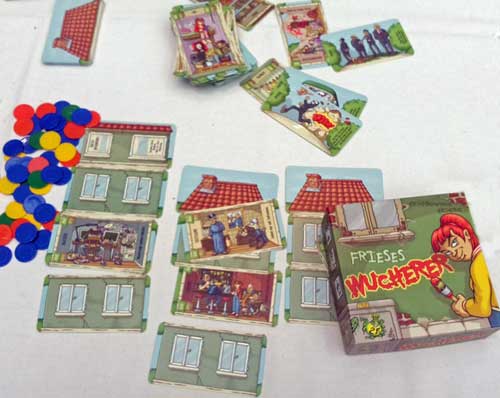 2F Spiele is Friedemann Friese’s imprint for the games he designs. This year he had a new edition of his very first published game: Wucherer. The game was later produced in English by Rio Grande as Landlord. The new edition is Friese’s Landlord (Frieses Wucherer in German). It has new artwork and has been sharpened up a bit,
but it remains
the same delightfully anarchic
card game
of unscrupulous landlords.
2F Spiele is Friedemann Friese’s imprint for the games he designs. This year he had a new edition of his very first published game: Wucherer. The game was later produced in English by Rio Grande as Landlord. The new edition is Friese’s Landlord (Frieses Wucherer in German). It has new artwork and has been sharpened up a bit,
but it remains
the same delightfully anarchic
card game
of unscrupulous landlords.
The cards are an interesting shape, somewhat longer than standard playing cards. They are a mixture of action cards and tenants. However, on the reverse, they are all a storey of a house. Played face down, this is what they are, forming the buildings into which tenants can be played. Tenants provide income, which allows players to buy more cards. However, having the most money is how you win the game. There is thus a decision to make: how much to spend and how much to keep. As you’d expect, you will probably be buying more cards early on and keeping the money later.
The action cards are what makes the game so much fun as they allow you to move other players’ tenants into your buildings, plant squatters in their empty apartments or even blow up whole buildings! Yes, it’s not a particularly serious game. However, despite all the mayhem, players will establish a stock of buildings and build up their income – even if erratically – from their tenants. There are some nice new touches, like the scientist tenant who creates a monster each round. This is good news, because even monsters need apartments to live in! It’s great fun and I’m really pleased to see it back in print. I give Friese’s Landlord a solid 9/10 on my highly subjective scale.
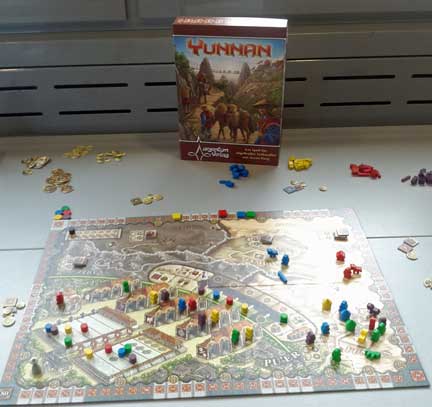 Argentum is a publisher that seems to get overlooked. They produce some solid, entertaining games and their latest is Yunnan, a first game, I believe, designed by Aaron Haag. The theme of this game is selling tea along “the great tea road” through the provinces of China. Players start with a few trader pawns (meeples) which they use each round either to bid
for (and use) improvements
or to trade tea in the provinces. There is a neat bidding mechanism for the improvements where players can outbid each
other, but it is possible for multiple players to get each improvement. These include gaining more traders, more movement or extending the range of their traders along the road.
Argentum is a publisher that seems to get overlooked. They produce some solid, entertaining games and their latest is Yunnan, a first game, I believe, designed by Aaron Haag. The theme of this game is selling tea along “the great tea road” through the provinces of China. Players start with a few trader pawns (meeples) which they use each round either to bid
for (and use) improvements
or to trade tea in the provinces. There is a neat bidding mechanism for the improvements where players can outbid each
other, but it is possible for multiple players to get each improvement. These include gaining more traders, more movement or extending the range of their traders along the road.
Once the improvements have been dealt with, traders who were not used in the bidding are moved along the road. The further they go, the more they will get for their tea, of course. However, players must maintain a continuous trade route back to base. This is where the tactical action of bumping players back along the road comes in handy. Players take their income, but leave their traders in the provinces. This is good for maintaining trade routes and income, but reduces the number of traders you have for bidding in the next round.
Another neat touch is that players must decide whether to take their income as cash or as victory points. Cash left at the end is still worth points, but at 3 Yuan for 1 point rather than one for one. Yunnan is a clever game with some neat mechanisms and I give it an initial 7/10 on my highly subjective scale.
One of the new games from Eggertspiele is Glück Auf from the esteemed team of Wolfgang Kramer and Michael Kiesling. The English title is Coal Baron, which is much more comprehensible for Anglophones, and is published by R&R Games. In this game each player has their own coal mine, complete with pithead and a cage that travels up and down the shaft. Okay, they’re just printed on cardboard, but they do look good.
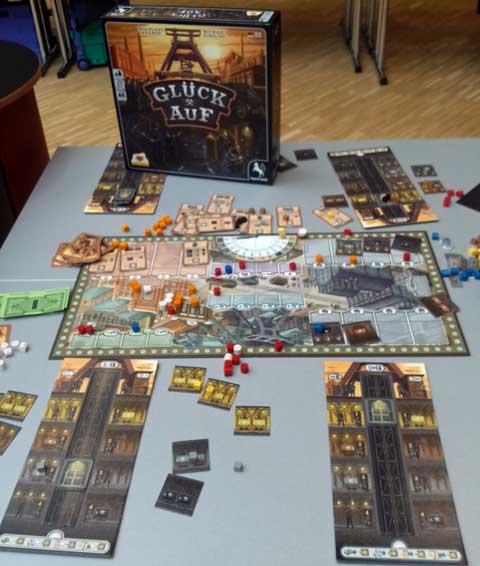
Coal Baron - okay, Glück Auf - on display
Players place their worker pawns in order to carry out actions. These allow them to extend their mine, dig out coal and ship it to fulfil contracts. It is, of course, completing the contracts that earns the points you need to win. Actions can be taken more than once in a round, but cost more workers each time. Other actions allow players to improve their facilities and there are all sorts of bonuses for getting sets of things. In particular, coal comes in several different grades (colours) from different depths of the mine. The deeper the coal, the more valuable, of course, and there are bonuses for each grade.
On first acquaintance, I found Coal Baron an enjoyable game, but lighter than I was expecting. It gets an initial 6/10 on my highly subjective scale.
Granna is a new name to me and is a Polish publisher. Their first game, which appears to have some serious marketing behind it, is CV, designed by Filip Milunski. Players create the story of a life by acquiring cards that represent different aspects of that life: career, relationships, possessions and so on. They get the cards by rolling dice Yahtzee-style and using the appropriate symbols to buy one or two cards. Each card goes into a stack of that particular category and the top card of each category provides bonuses – usually extra symbols, but sometimes an extra die to roll or some other advantage.
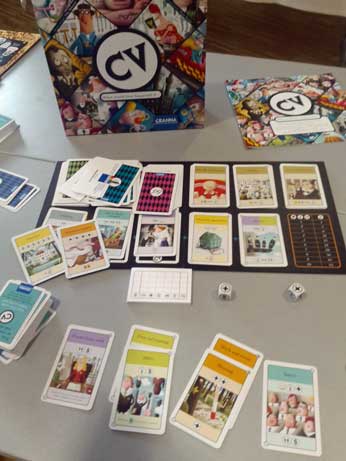 The game proceeds through three decks of cards, representing youth, maturity and old age. The cards get more expensive, but players also have more resources with which to buy them. You see, just like life! Once the cards run out, players score points according to their own secret goal as well as the public goals revealed at the start of the game. They also get points for the cards
they have in each category and the most points wins.
The game proceeds through three decks of cards, representing youth, maturity and old age. The cards get more expensive, but players also have more resources with which to buy them. You see, just like life! Once the cards run out, players score points according to their own secret goal as well as the public goals revealed at the start of the game. They also get points for the cards
they have in each category and the most points wins.
At the end of CV you really do have a life laid out in front of you – in my first game, I took early retirement from my internship and loafed around! The obvious comparison for gamers is Friedemann Friese and Marcel-André Casasola Merkle’s Funny Friends, which covers the same ground in a lot more detail. CV is a much simpler game and, I suspect, aimed at a family audience. It is a decent way of filling an hour, though, and provides plenty of amusement as players see how each life turns out. My preliminary rating is 6/10 on my highly subjective scale.
French publisher Grosso Modo had an entertaining take on Werewolf in the form of Nosferatu, designed by Pierre-Yves Lebeau. To begin with, one player takes the role of Renfield and will act as a kind-of-GM, managing each round. However, Renfield is on the vampire’s side and his first job is to choose a player to be the vampire. Then he gives the stake to one of the players. This is a one-shot weapon: stake the vampire and the hunters win; stake a hunter and the vampire (and Renfield) wins.
Each round players play a card (face-down) and discard one (face-up), then Renfield draws a card from the control deck. What you discard may help other players work out whose side you’re on, of course. The round continues until all have played or Renfield draws sunrise. He then reveals the cards played. If they’re all laboratories, the hunters get some help. However, if there’s a bite, the vampire has struck and one of the hunters is bitten. Five bites and it’s all over!
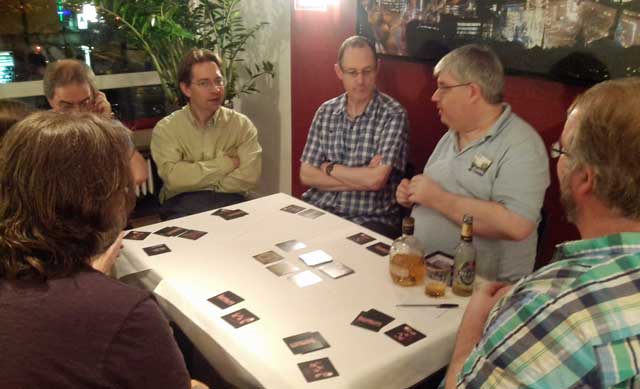
Playing Nosferatu in the Hotel Jung on Saturday evening, led by Chris Dearlove
Nosferatu has a very different appeal from Werewolf. Unlike the freeform fun of that game, this rewards thoughtful play and puts both teams under pressure. It’s a clever game that I expect to see a lot more of. Having played it a few times now, I give it a solid 8/10 on my highly subjective scale.
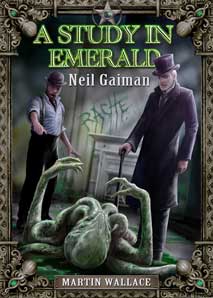 Treefrog – Martin Wallace’s imprint – had three new games for us. The Witches is Martin’s second Discworld-themed game (after Ankh-Morpork), but this is the one I haven’t played yet. The big game is Study in Emerald, based on a Neil Gaiman story. The setting is a bizarre Edwardian (I think) Europe that is ruled by Lovecraftian gods (Cthulhu et al).
Players are secretly
assigned to one of
two factions.
The revolutionaries (acid pink) seek to overthrow their rulers, largely by assassinating them! The loyalists
(lurid green) defend the Old Ones and try to stop the revolutionaries.
Treefrog – Martin Wallace’s imprint – had three new games for us. The Witches is Martin’s second Discworld-themed game (after Ankh-Morpork), but this is the one I haven’t played yet. The big game is Study in Emerald, based on a Neil Gaiman story. The setting is a bizarre Edwardian (I think) Europe that is ruled by Lovecraftian gods (Cthulhu et al).
Players are secretly
assigned to one of
two factions.
The revolutionaries (acid pink) seek to overthrow their rulers, largely by assassinating them! The loyalists
(lurid green) defend the Old Ones and try to stop the revolutionaries.
Players recruit agents and move them about Europe, taking control of cities, fighting each other and carrying out assassinations and other outrages. The success of each faction is measured by a marker on a track of their colour and the game ends when a track is completed. Players now reveal which faction they belong to and tot up their scores. However, nobody in the same faction as the player with the lowest score can win! The winner is the highest scorer of the other faction.
This means Study in Emerald has a cooperative aspect. You can’t afford to let another player in your faction come last! Of course the problem is identifying them. And making it obvious which faction you belong to makes you a target for the other side! This is very clever, not least because it makes the game viable if only one player belongs to a faction. They just have to make sure one of the opposition does worse than them. This is excellent stuff from Martin Wallace, enhanced by the atmospheric artwork. I’ve only played it once, but I’ll give it a provisional 8/10 on my highly subjective scale.
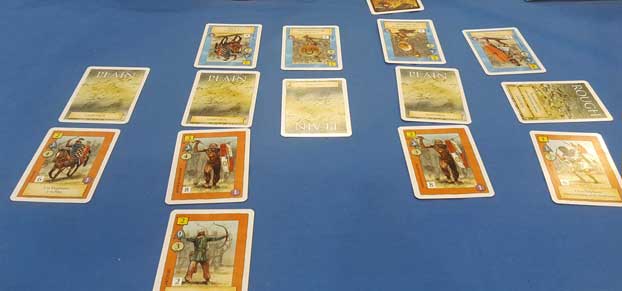
Go red army! But it’s a pretty even fight in Field of Glory: the card game
The third Treefrog game is Field of Glory: the card game. The name meant nothing to me, but apparently Field of Glory is a renowned set of rules for miniatures wargames in the Ancient (and also Mediaeval) period. The card game is a two-player contest of Ancient armies, presumably drawing on these wargames rules.
At the start of a game players go through the deck of cards for the side they’ve chosen and discard half of them. This gives them some control over the composition of their ‘army’. For example, a player might leave out the elephants or concentrate on cavalry. Terrain cards are laid out between the players and this is their battleground: they win by gaining the majority of the terrain.
In Dominion style, players have a hand of five cards which they play and replace from their deck. In a turn, players use some cards as ‘Command’ points to deploy other cards as troops. They may make one attack – there are specific rules for outflanking and other tactical situations – and gain control of any terrain where they are unopposed. If no-one has won when both decks have run out, the winner is the player who’s defeated the greater value of enemy units. Field of Glory – the card game makes clever use of the deck tuning and management mechanisms, but it’s not my type of game. Though I would happily play it again. I give it 6/10 on my highly subjective scale.
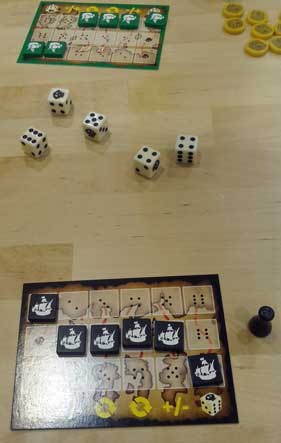
Playing Buccaneer Bones – it’s a quick little dice game
This brings us to Kris Gould and his imprint, Wattsalpoag. Kris described his new game as a “quick little dice game” and this is exactly what Buccaneer Bones is. Players roll dice, looking to make pairs or triples of any number. These allow them to move the pirate ship in the appropriate column of their little board. When a ship reaches the bottom of the column, the player gets a bonus – an extra die, say – while it remains there. Roll a triple of the appropriate number and you get a treasure and the ship returns to ‘port’ at the top of the column. First to a specific number of treasures wins.
I have to say that Buccaneer Bones is a quick little dice game. There’s not too much to think about, so it rattles along at a good pace while the players decry or applaud their luck. It’s a neat filler and I give it 7/10 on my highly subjective scale.
White Goblin is not a publisher I mention much, but they produce the Dutch/Belgian versions of many familiar titles as well as producing their own games. This year one of those is Packet Row, designed by Åse and Henrik Berg. In this game, players run packet ships and aim to fulfil contracts by buying and shipping the appropriate goods. The heart of the game is a clever bidding mechanism through which the players acquire goods, contracts, ships, money and crew and gain various advantages to improve their future turns. The bidding provides some tactical options and the opportunity – certainly when playing with just two, as I did – to bluff and, hopefully, outsmart your opponents. Packet Row is a nice enough game, but it didn’t grab me. I give it an initial 6/10 on my highly subjective scale.
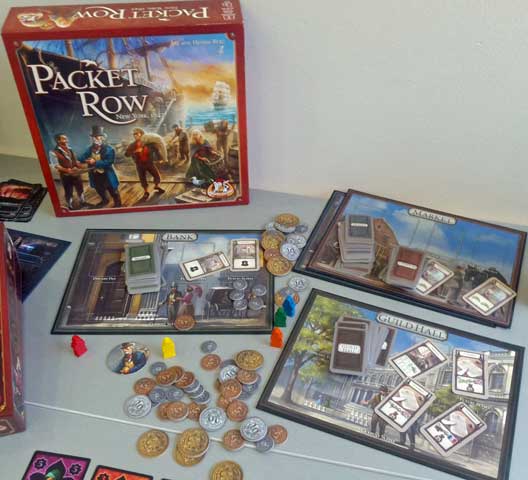
As always, Spiel was great fun with a huge number of new games on show and the organisers, Friedhelm Merz Verlag, did their usual excellent job. Next year’s Spiel is scheduled for 16-19th October 2014 and I intend to be there. To find out more, see the (English language) Friedhelm Merz Velag website
Photographs by Pevans, who played with Photoshop. Game artwork courtesy of the publishers, all trade marks acknowledged.
This report was first published in To Win Just Once 140 (December 2013).
